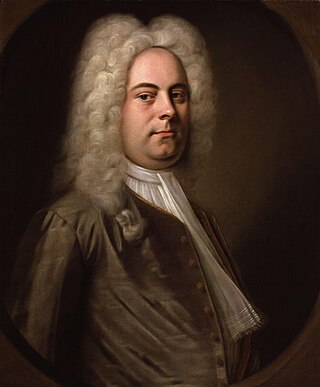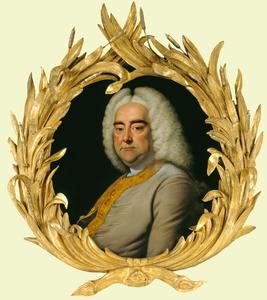
Alexander's Feast is an ode with music by George Frideric Handel set to a libretto by Newburgh Hamilton. Hamilton adapted his libretto from John Dryden's ode Alexander's Feast, or the Power of Music (1697) which had been written to celebrate Saint Cecilia's Day. Jeremiah Clarke set the original ode to music.
Salve Regina is an antiphon composed by George Friederic Handel around 1707. It is most likely that the work was first performed for Trinity Sunday in Vignanello on 19 July 1707 in the Church of Santa Maria in Montesanto, under the patronage of the Colonna family. Other catalogues of Handel's music have referred to the work as HG xxxviii, 136.
As pants the hart is an anthem composed by George Frideric Handel for the Chapel Royal of Queen Anne and subsequently revised. There are five versions of the work, the first being completed in 1713, and the final in 1738. HWV 251a was the first anthem Handel composed for the Chapel Royal.
Fitzwilliam Sonatas is the name first given by Thurston Dart to an arrangement he made, based on two recorder sonatas by George Frideric Handel, which he recast as a group of three sonatas. The term was applied by later editors to the original two sonatas as Handel wrote them, and was also expanded to encompass several other sonatas for various instruments included in the Handel autograph manuscripts held by the Fitzwilliam Museum in Cambridge.

The Handel organ concertos, Op. 4, HWV 289–294, are six organ concertos for chamber organ and orchestra composed by George Frideric Handel in London between 1735 and 1736 and published in 1738 by the printing company of John Walsh. Written as interludes in performances of oratorios in Covent Garden, they were the first works of their kind for this combination of instruments and served as a model for later composers.

The Handel organ concertos, Op. 7, HWV 306–311, refer to the six organ concertos for organ and orchestra composed by George Frideric Handel in London between 1740 and 1751, published posthumously in 1761 by the printing company of John Walsh. They were written for performance during Handel's oratorios, contain almost entirely original material, including some of his most popular and inspired movements.
A fine and delicate touch, a volant finger, and a ready delivery of passages the most difficult, are the praise of inferior artists: they were not noticed in Handel, whose excellencies were of a far superior kind; and his amazing command of the instrument, the fullness of his harmony, the grandeur and dignity of his style, the copiousness of his imagination, and the fertility of his invention were qualities that absorbed every inferior attainment. When he gave a concerto, his method in general was to introduce it with a voluntary movement on the diapasons, which stole on the ear in a slow and solemn progression; the harmony close wrought, and as full as could possibly be expressed; the passages concatenated with stupendous art, the whole at the same time being perfectly intelligible, and carrying the appearance of great simplicity. This kind of prelude was succeeded by the concerto itself, which he executed with a degree of spirit and firmness that no one ever pretended to equal.
The Flute sonata in G major was composed by George Frideric Handel in F major for the oboe, and was transposed by an unknown hand to G major, for flute and basso continuo. The work is also referred to as Opus 1 No. 5, as it was first published in 1726 or slightly later by the London publisher Walsh, in an edition falsely attributed to Jeanne Roger of Amsterdam. Other catalogues of Handel's music have referred to the work as HG xxvii, 19; and HHA iv/3,28. The sonata was originally composed as an oboe sonata in F major.
The Flute sonata in E minor was composed by George Frideric Handel for flute and basso continuo. The work is also referred to as Opus 1 No. 1b, and was first published in 1732 by Walsh. Other catalogues of Handel's music have referred to the work as HG xxvii,6; and HHA iv/3,10.
The Flute sonata in B minor is a work for flute and basso continuo, however the sonata was originally composed by George Frideric Handel as a Recorder sonata in D minor . Other catalogues of Handel's music have referred to the work as HG xxvii, 32; and HHA iv/3,42.
The Oboe sonata in F major was composed by George Frideric Handel, for oboe and basso continuo. The work is also referred to as HHA iv/18,36.
The Flute sonata in E minor is thought to have been composed by George Frideric Handel, for flute and basso continuo. The date of composition of the work is unknown, but it was first published in 1730. Other catalogues of Handel's music have referred to the work as HG xlviii, 134; and HHA iv/3,63.
The Oboe sonata in C minor was composed by George Frideric Handel for oboe and basso continuo. The work is also referred to as Opus 1 No. 8, and was first published in 1732 by Walsh. Other catalogues of Handel's music have referred to the work as HG xxvii, 29; and HHA iv/18,32.
The Oboe Concerto No. 2 in B flat major was composed by George Frideric Handel for oboe, orchestra and basso continuo. It was first published in the fourth volume of Select Harmony by Walsh in 1740. Other catalogues of Handel's music have referred to the work as HG xxi, 91; and HHA iv/12,47.
The Oboe Concerto No. 1 in B flat major was composed by George Frideric Handel for oboe, orchestra and basso continuo. It was first published in the fourth volume of Select Harmony by Walsh in 1740. Other catalogues of Handel's music have referred to the work as HG xxi, 85; and HHA iv/12,17.
The Sonata in C major, for recorder and basso continuo, was composed by George Frideric Handel. The work is also referred to as Opus 1 No. 7, and was first published in or shortly after 1726—in a collection of twelve sonatas titled Sonates pour un Traversiere un Violon ou Hautbois Con Basso Continuo Composées par G. F. Handel—purportedly in Amsterdam by Jeanne Roger, but now shown to have been a forgery by the London publisher John Walsh. Walsh republished this sonata in 1731 or 1732 under his own imprint in a similar collection, containing ten of the earlier sonatas and two new ones, with the new title Solos for a German Flute a Hoboy or Violin With a Thorough Bass for the Harpsichord or Bass Violin Compos'd by Mr. Handel. Other catalogues of Handel's music have referred to the work as HG xxvii, 15; and HHA iv/3,33.

The Twelve Grand Concertos, Op. 6, HWV 319–330, by George Frideric Handel are concerti grossi for a concertino trio of two violins and cello and a ripieno four-part string orchestra with harpsichord continuo. First published by subscription in London by John Walsh in 1739, they became in a second edition two years later Handel's Opus 6. Taking the older concerto da chiesa and concerto da camera of Arcangelo Corelli as models, rather than the later three-movement Venetian concerto of Antonio Vivaldi favoured by Johann Sebastian Bach, they were written to be played during performances of Handel's oratorios and odes. Despite the conventional model, Handel incorporated in the movements the full range of his compositional styles, including trio sonatas, operatic arias, French overtures, Italian sinfonias, airs, fugues, themes and variations and a variety of dances. The concertos were largely composed of new material: they are amongst the finest examples in the genre of baroque concerto grosso.
The Musette, or rather chaconne, in this Concerto, was always in favour with the composer himself, as well as the public; for I well remember that HANDEL frequently introduced it between the parts of his Oratorios, both before and after publication. Indeed no instrumental composition that I have ever heard during the long favour of this, seemed to me more grateful and pleasing, particularly, in subject.
The Violin sonata in G minor is a work for violin and basso continuo that was originally thought to have been composed by George Frideric Handel. Modern scholars however believe it doubtful that the work was composed by Handel, and have labelled it as "spurious". The work is also referred to as Opus 1 No. 10, and was first published in 1732 by Walsh. Other catalogues of Handel's music have referred to the work as HG xxvii,37; and HHA iv/4,28.
The Sonata in F major was composed by George Frideric Handel for recorder and basso continuo. The work is also referred to as Opus 1 No. 11, and was first published in 1732 by Walsh. Other catalogues of Handel's music have referred to the work as HG xxvii, 40; and HHA iv/3,52.
The Violin sonata in G minor was composed by George Frideric Handel for violin and basso continuo. The work is also referred to as Opus 1 No. 6, and was first published in 1732 by Walsh. Other catalogues of Handel's music have referred to the work as HG xxvii,22; and HHA iv/18,6. Also published in HG xlviii,118.

The Concerti grossi, Op. 3, HWV 312–317, are six concerti grossi by George Frideric Handel compiled into a set and published by John Walsh in 1734. Musicologists now agree that Handel had no initial knowledge of the publishing. Instead, Walsh, seeking to take advantage of the commercial success of Corelli's Concerti grossi, Op. 6, simply combined several of Handel's already existing works and grouped them into six "concertos".





